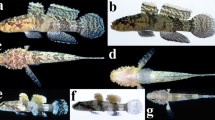Abstract
The morphology and infraciliature of a new marine colepid ciliate, Apocoleps magnus gen. nov., spec. nov., are described based on living observations and silver impregnations. The new genus Apocoleps is characterized by having 8 (vs. 6 in most other related genera) armour tiers, spines at both ends of the cell, 3 adoral organelles and plates with 4 reniform uni-windows. Apocoleps magnus spec. nov. is defined by the following features: body elongated and slightly curved, about 100–120µm× 35–45 µm in vivo; anterior tertiary tier plate with four uni-windows, most secondary and main tier plates with four uni-windows, posterior tertiary tier plate with two uni-windows; left plate margin slightly serrated; on average 23 transverse and 22 longitudinal ciliary rows; one terminal contractile vacuole; marine habitat.
Similar content being viewed by others
References
Aescht, E., 2001. Catalogue of the generic names of ciliates (Protozoa, Ciliophora). Denisia, 1: 1–350.
Bergh, R. S., 1881. Bidrag til Cilioflagellaternes Naturhistorie. Videnskabel. Meddel. Fr. D. Naturhist. Forening Kjobenhavn., 3: 60–76.
Corliss, J. O., 1979. The Ciliated Protozoa: Characterization, Classification and Guide to the Literature. 2nd edition. Pergamon Press, Oxford, 1–455.
Diesing, K. M., 1865. Revision der Prothelminthen. Abtheilung: Amastigen. I. Amastigen ohne Peristom. Sber. Akad. Wiss. Wien., 52: 505–579.
Dragesco, J., and Dragesco-Kernéis, A., 1991. Free-living ciliates from the coastal area of Lake Tanganyika (Africa). Eur. J. Protistol., 26: 216–235.
Foissner, W., 1983. Taxonomische Studien über die Ciliaten des Großglocknergebietes (Hohe Tauern, Österreich) I. Familien Holophryidae, Prorodontidae, Plagiocampidae, Colepidae, Enchelyidae und Lacrymariidae nov. fam. Ann. Naturh. Mus. Wien., 84B: 49–85.
Foissner, W., 1984. Infraciliatur, Silberliniensystem und Biometrie einigerneuer und wenig bekannter terrestrischer, limnischer und mariner Ciliaten (Protozoa: Ciliophora) aus den Klassen Kinetofragminophora, Colpodea und Polyhymenophora. Stapfia, 12: 1–165.
Foissner, W., Berger, H., and Kohmann, F., 1994. Taxonomische und ökologische Revision der Ciliaten des Saprobien- systems-Band III: Hymenostomata, Prostomatida, Nassulida. Informationsber Bayer. Landesamtes Wasserwirtschaft., 1/94: 1–548.
Foissner, W., Berger, H., and Schaumburg, J., 1999. Identification and ecology of limnetic plankton ciliates. Informationsber. Bayer. Landesamtes Wasserwirtschaft., 3/99: 1–793.
Foissner, W., Kusuoka, Y., and Shimano, S., 2008. Morphology and gene sequence of Levicoleps biwae n. gen., n. sp. (Ciliophora, Prostomatida), a proposed endemic from the ancient Lake Biwa, Japan. J. Eukaryot. Microbiol., 55: 185–200.
Hu, X., 2008. Cortical structure in non-dividing and dividing Diophrys japonica spec. nov. (Ciliophora, Euplotida) with notes on morphological variation. Eur. J. Protistol., 44: 115–129.
Kahl, A., 1930. Urtiere oder Protozoa I: Wimpertiere oder Ciliata (Infusoria) 1. Allgemeiner Teil und Prostomata. Tierwelt. Dtl., 18: 1–180.
Kahl, A., 1935. Urtiere oder Protozoa I: Wimpertiere oder Ciliata (Infusoria) 4. Peritricha und Chonotricha. Tierwelt Dtl., 30: 651–886.
Lynn, D. H., 2008. The Ciliated Protozoa: Characterization, Classification and Guide to the Literature. 3rd edition. Springer, 604pp.
Ma, H., Choi, J. K., and Song, W., 2003. An improved silver carbonate impregnation for marine ciliated protozoa. Acta. Protozool., 42: 161–164.
Nitzsch, C. L., 1827. Cercaria. In: Allgemeine Encyclopädie der Wissenschaften und Künste. Ersch, J. S., and Gruber, J. G., eds., Theil 16. F. Gleditsch, Leipzig, 66–69.
Noland, L. E., 1937. Observations on marine ciliates of the Gulf Coast of Florida. Trans. Am. Micros. Soc., 56: 160–171.
Obolkina, L. A., 1995. New species of the family Colepidae (Prostomatida, Ciliophora) from Lake Baikal. Zool. Zh., 74: 3–19.
Small, E. B., and Lynn, D. H., 1985. Phylum Ciliophora Doflein, 1901. In: An Illustrated Guide to the Protozoa. Lee, J. J., et al., eds., Society of Protozoologists, Lawrence, KS, 393–575.
Song, W., and Wilbert, N., 1995. Benthische Ciliaten des Süßwassers. In: Praktikum der Protozoologie. Röttger, R., ed., Gustav Fischer Verlag, New York, 156–168.
Wilbert, N., and Schmall, G., 1976. Morphologie und Infraciliatur von Coleps nolandi Kahl, 1930. Protistologica, 12: 193–197.
Author information
Authors and Affiliations
Corresponding author
Rights and permissions
About this article
Cite this article
Chen, X., Warren, A. & Song, W. Taxonomic studies on a new marine ciliate, Apocoleps magnus gen. nov., spec. nov. (Ciliophora, Colepidae), isolated from Qingdao, China. J. Ocean Univ. China 8, 317–321 (2009). https://doi.org/10.1007/s11802-009-0317-0
Received:
Revised:
Accepted:
Published:
Issue Date:
DOI: https://doi.org/10.1007/s11802-009-0317-0




